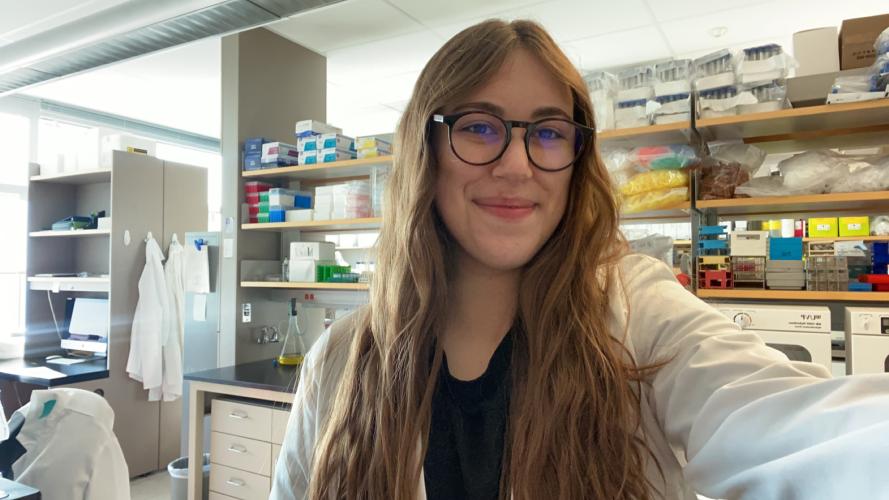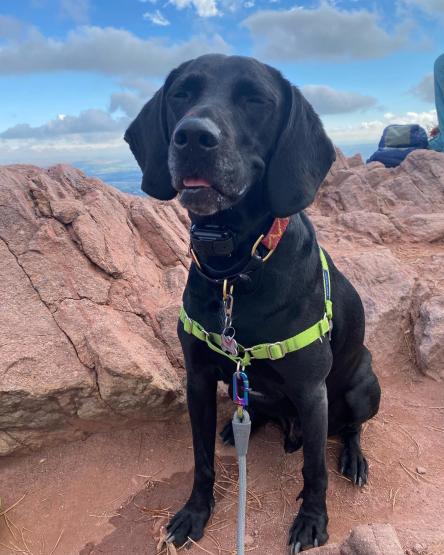
OHIO alumna uses classroom knowledge to further zebrafish research

The knowledge one learns in a classroom setting can be proven useful in unexpected ways later on.
When Erin Binne took an Animal Behavior class taught by Professor Molly Morris, she had no idea some of the lessons she learned then would help her keep an entire colony of zebrafish alive later for her future job.
Binne, B.S. ’19, majored in biological sciences from the College of Arts and Sciences. Originally from Cincinnati, Binne packed up and moved to Colorado after graduating from Ohio University in May 2019.
Since graduation, Binne has worked as a professional research assistant at the University of Colorado’s School of Dental Medicine, in their craniofacial biology department. She assists with taking care of the animal colonies, genotyping the animals, ordering and stocking lab supplies, and troubleshooting various tasks around the lab.
“I love my job. I really enjoy getting to do the physical bench work of research,” Binne said. “When I was at OHIO, I worked within the Diabetes Center. I was volunteering in the lab for Dr. Chunmin Lo – having that experience pretty much led me into the field because, before that, I thought I wanted to go to medical school. But then I fell in love with research.”
While working at the University of Colorado, Binne was in charge of taking care of a colony of zebrafish. At one point, there was only one male fish left of a specific gene and the colony was in risk of dying out.
Binne remembered Professor Morris’ class, as well as her expertise working with swordtail and platy fishes in the Morris Laboratory. She realized that the fishes in the Morris Lab and her current lab mated in similar ways.
“There are different types of male fish,” Binne explained. “There’s a typical male fish, but then there’s these ones called sneaker males. Basically, they sneak around and are in the tank with both the female and the larger, more preferred male in the tank, let’s say the ‘good’ male. The ‘good’ male will do all the reproductive work, coordinating with the female and everything. But when the female lays her eggs, the sneaker, smaller male swoops in and fertilizes the eggs before the ‘good’ male can. It’s evolutionary – it’s how the smaller males have figured out how to survive their line.”
The last male fish left in the zebrafish colony had a really curved spine, like scoliosis in humans. While he could swim and was healthy, aesthetically he may not get chosen by a female fish to mate with, Binne explained. This was what continued to happen, over and over, when she would set up potential fish to mate with the remaining male in a shallow water tank for breeding.
“I kept thinking, ‘oh gosh, what are we going to do?’ But then I remembered Professor Morris’ class and how she had these sneaker males and basically set them up to breed the same way,” Binne continued. “So, I found a large wildtype male in there with a wildtype female, along with the male fish we had left, and then all the courting happened correctly. When I genotyped the embryos afterwards, I had the positive embryos for the line, which meant that line was back again.”
Even one breeding success is huge for the research team – one female zebrafish can produce around 100 eggs every time, she explained.
After the successful mate, Binne wanted to reach out to Morris to let her know the news – and thank her for her teaching.
“None of us were even sure if this would work in zebrafish. This was really a last-ditch effort before we possibly sacrificed the one male we had left to do insemination. So, once it worked, everyone in the lab was super excited,” Binne said. “I just wanted her to know what she taught me has been used in the real-world application for me, and I was just really excited.”
Morris, likewise, was thrilled to hear from the former student – including her involvement in research, as well as using the knowledge she learned in her class to save the zebrafish line.
“It was so thoughtful of Erin to write to me,” Morris said. “As faculty, you often have no idea of the impact you have on students or their careers. So, a huge thank you to Erin for sharing her story with me.”

When Binne studied at OHIO, she was involved with the women’s club crew team, a rowing team. One of her teammates was involved in a lab with an open position, which is how Binne eventually learned her love for research.
“Essentially the connections I had at OHIO got me into the lab there, and then getting all that experience, actually doing the things that I do now, helped prepare me for my job today,” she said.
Binne is thankful for her time at OHIO and in Athens, as she also found her best friend and dog – aptly named – Fish. Binne’s friend found him in a parking lot a few weeks before the start of their senior year, and Fish has been with her ever since.
“I miss the small-town feel of Athens. Living in suburbia and then going to Athens and being able to walk everywhere was like magic,” she said. “Students should definitely not miss just experiencing Athens.”
